Paris-Brest, a delicate ring shape Choux pastry with Hazelnut Praline Crème Mousseline filling, is definitely the Queen of French pastries! Crispy Pâte à Choux bonds together with silky, nutty Creme Mousseline filling in my Classic French recipe! Extra praline paste and roasted hazelnuts in the filling bring additional crunchiness making this Paris-Brest one of the most impressive desserts of all!
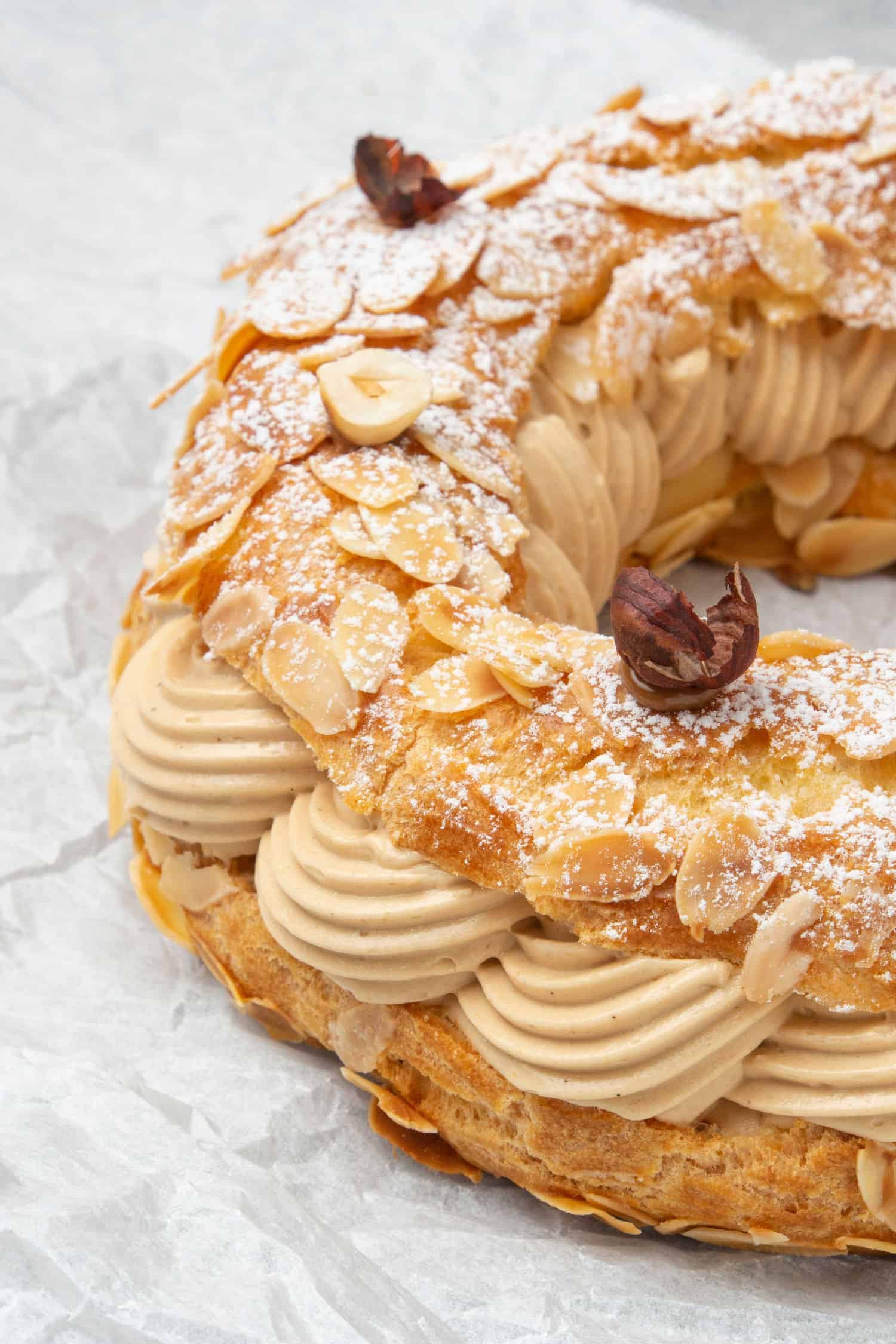
Jump to:
- 🌟 Why this is the best Paris-Brest recipe
- 💪 How hard it is to make this recipe
- 📖 History of Paris-Brest
- 💡 What is Crème Mousseline
- 📝 Ingredient notes
- 👩🍳 How to make this recipe
- 🥣 Equipment notes
- 🎓 Expert tips
- ❓Recipe FAQs
- ✨ More Choux pastry recipes
- 🔥 Join my Ferrero Rocher inspired Paris-Brest dessert Online Baking Class
- ULTIMATE Paris-Brest (VIDEO)
🌟 Why this is the best Paris-Brest recipe
While making Paris-Brest the perfect result we are looking for is a ring shape choux pastry that is risen evenly (so no major cracks on the side), holds its shape after baking, and has a lovely huge air pocket inside the choux that can be filled with a stable yet silky Hazelnut Praline Crème Mousseline.
My Paris-Brest recipe will teach you all the below and even more;
1. How to achieve evenly baked choux pastry with no major cracks on the surface. I have tons of tips along the way to avoid typical beginner mistakes
2. How to make the most delicious, silkiest ever Paris-Brest filling; Hazelnut Praline Crème Mousseline, that is light yet able to hold its shape. Temperature is the most important factor while whipping up this cream, see my tips below
3. How to assemble the Paris-Best so it looks super elegant and a showstopper dessert on your dinner table
This is a professional Paris-Brest recipe that is adapted to the home kitchen environment. I will cover all the necessary information you probably haven´t read anywhere else so your Paris-Brest will turn out just like you would bough it from a fancy French pastry shop!
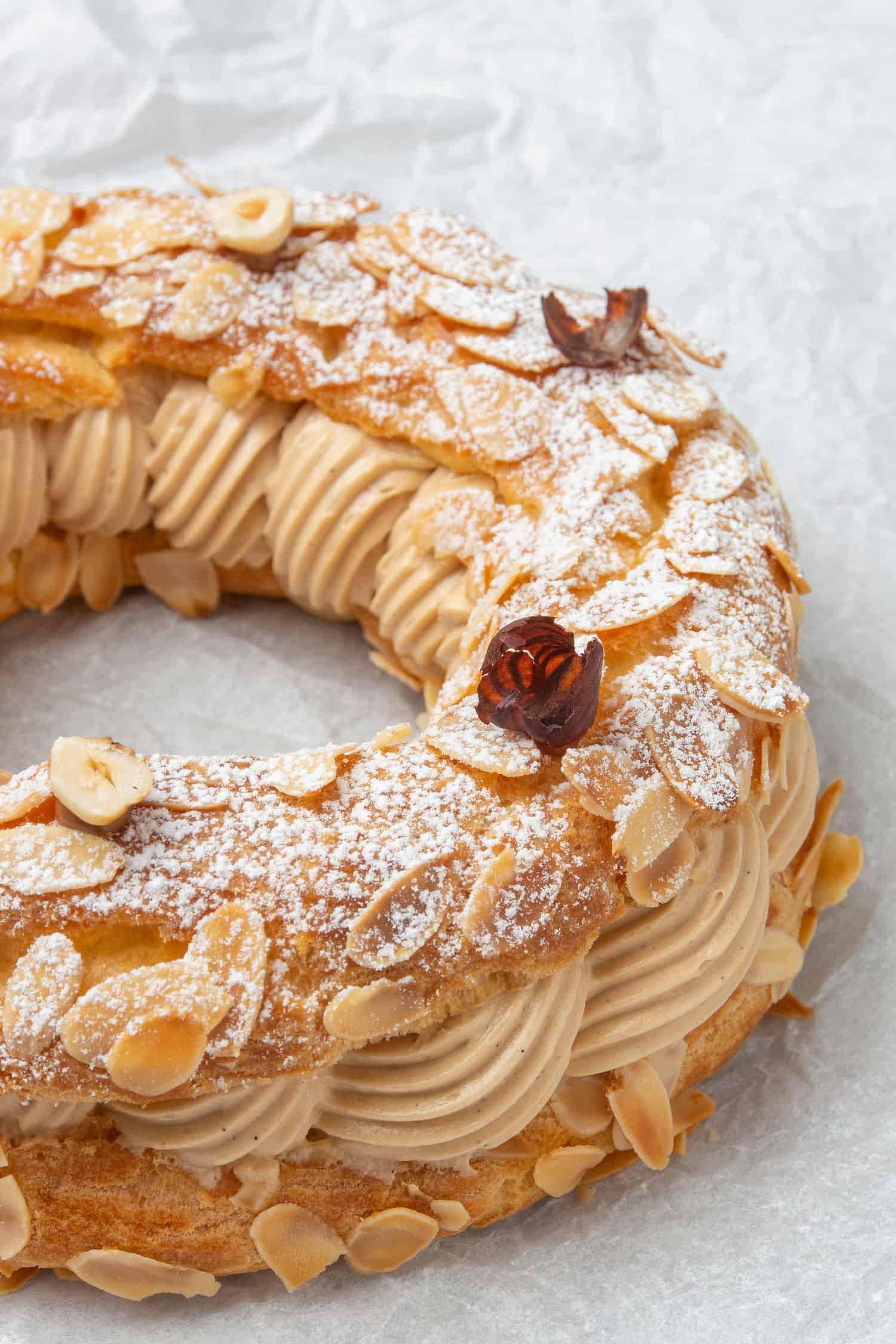
💪 How hard it is to make this recipe
Making this Paris-Brest recipe is actually not that hard, neither too complex nor time-consuming. What makes this recipe way easier than many other recipes out there is that I have step-by-step easy-to-follow instructions for you with tons of baking tips along the way!
The Pâte à choux itself comes together really easily using a handful of ingredients. The Hazelnut Praline Crème Mousseline filling is also quite an easy type of cream if you follow some basic baking rules that I will be sharing along the way. The most difficult part of the recipe is probably piping a ring shape, however, you can always practice that until you feel comfortable with the result.
The recipe might look long, and in fact, it is, because of the necessary information you need to know in order to succeed. Consider this recipe as a full-on Paris-Brest and Choux pastry crash course, the only Paris Brest recipe that you will ever need!
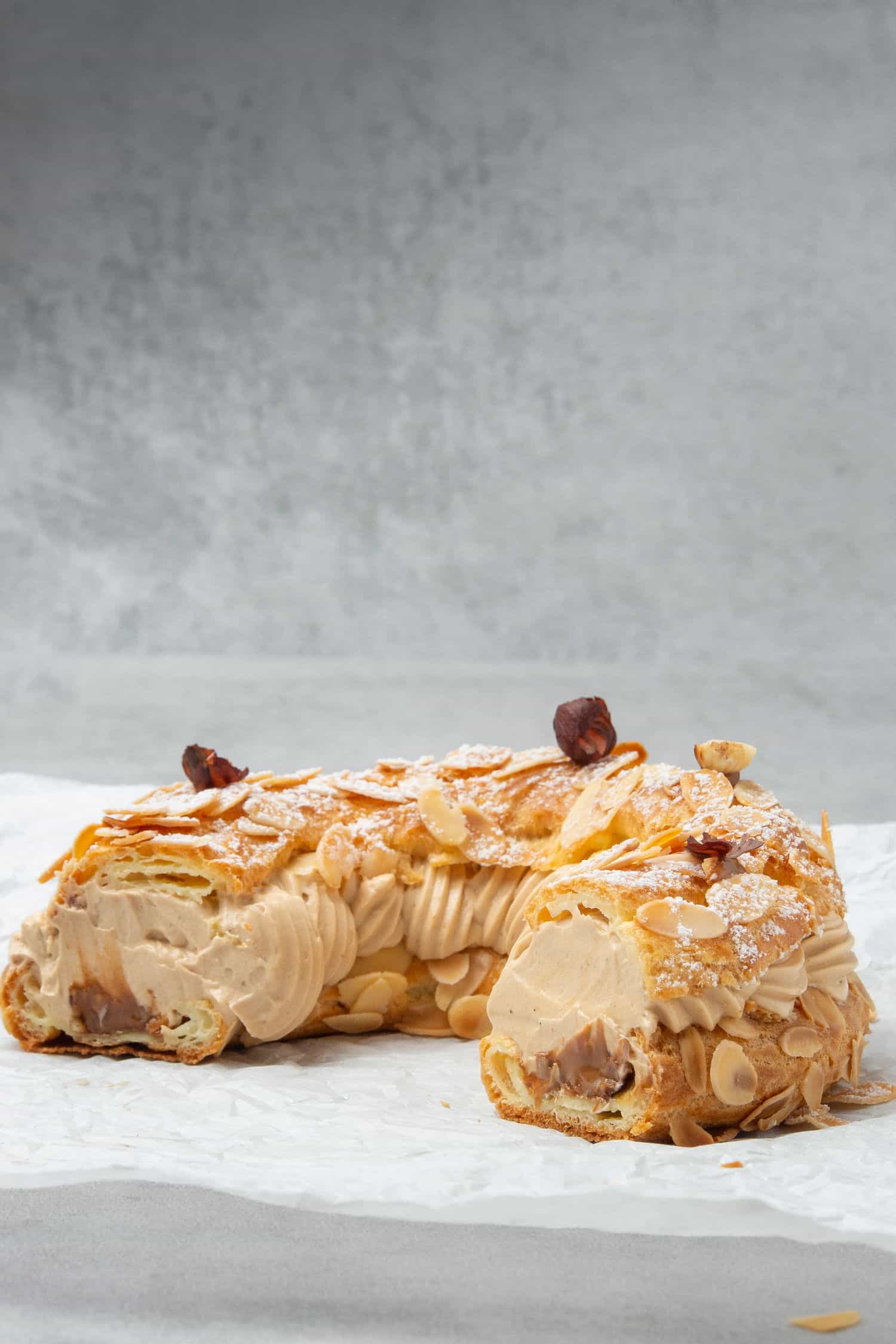
📖 History of Paris-Brest
The round pastry, in the form of a wheel, was created in 1910 by Pastry chef Louis Durand to commemorate the Paris–Brest–Paris bicycle race. Its circular shape is representative of a bike wheel. It became popular with riders on the Paris–Brest cycle race, partly because of its energizing high calorific value, its intriguing name, and because it is irresistibly delicious!
Paris–Brest what we know today is an elegant, round-shaped French dessert, made of choux pastry - just like eclair, cream puff, choux au craquelin, profiterole, etc. Paris-Brest is typically filled with praline flavored cream, called Crème Mousseline. Paris Brest is widely popular in French-style pastry shops (check where to find the best Paris-Brest in Paris!) and the good news is that it is totally doable to make even for hobby home bakers! Besides the traditional hazelnut flavored dessert, other popular flavors can be Paris Brest pistachio, Paris Brest au chocolat, Paris Brest raspberry pistachio, etc.
This Hazelnut Paris Brest is definitely a must-make if you like French pastries and Pâte à choux in particular! It is hands down the most delicious choux ever!
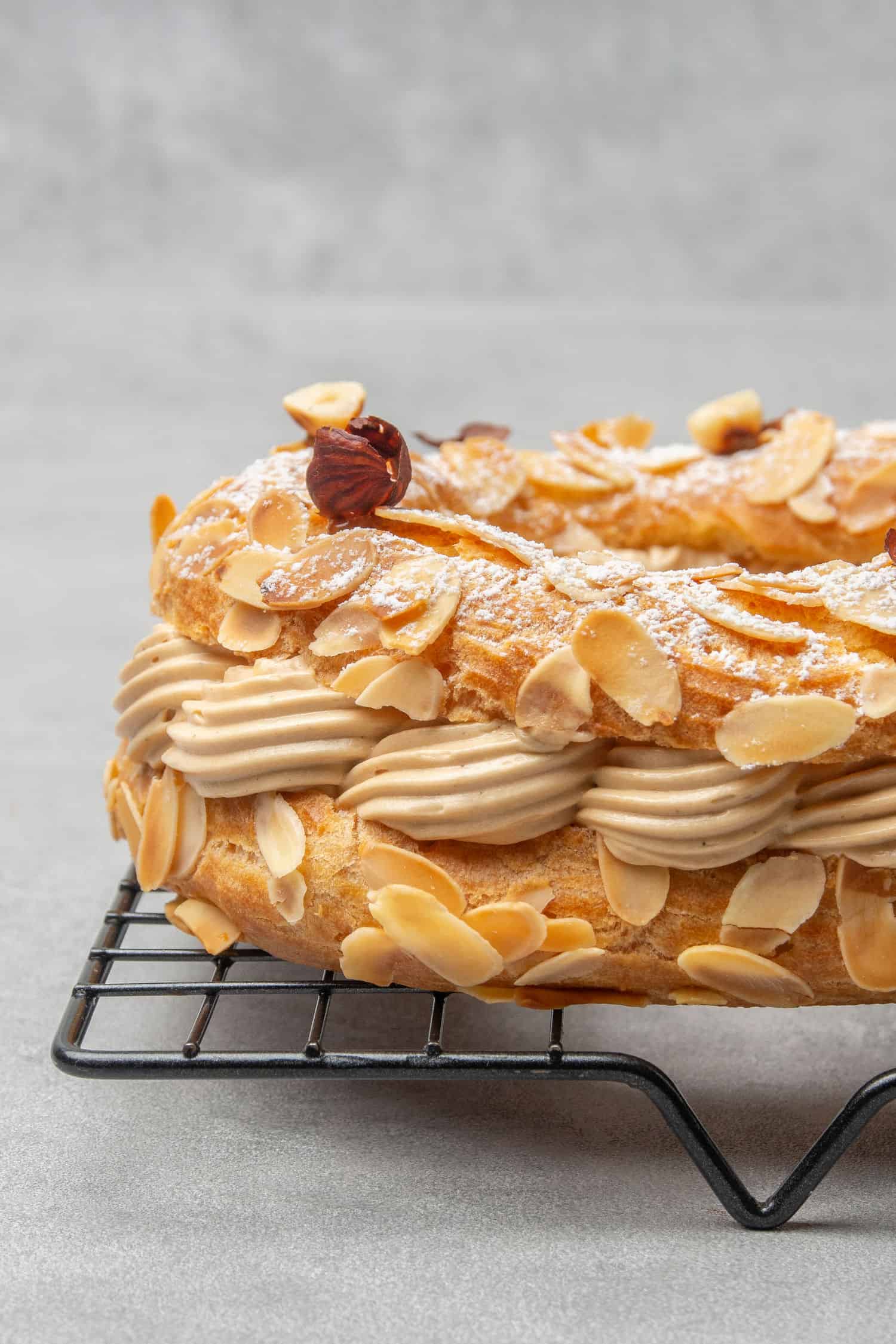
💡 What is Crème Mousseline
Crème Mousseline (also called German buttercream) is a silky, fluffy yet stable cream made of pastry cream and butter. It can be used as a cream filling for cakes, and cupcakes and it is also super popular in French-style recipes eg. Fraisier cake, Sable Breton tart, Charlotte cake, or this Paris Brest.
Crème pâtissière (pastry cream) is the perfect base for other custard-like creams:
- Crème Diplomat: Crème Diplomat is a lighter version of the French Pastry Cream (Crème Pâtissière). Basically, it is Crème Pâtissière with added whipped cream and gelatin (optionally). Whipped cream makes it lighter and fluffier and the gelatin makes it more stable. Gelatin is not strongly needed, depending on the type of cake
- Crème Mousseline: Crème Mousseline is classic Pastry Cream enriched with fluffy butter that makes the pastry cream extra rich and also more stable to pipe kind of like buttercream but way more delicious.
Classic Hazelnut Paris Brest is filled with Hazelnut Praline Crème Mousseline that is pastry cream flavored with hazelnut praline paste and enriched with butter. It is the most delicious cream filling you will ever make!
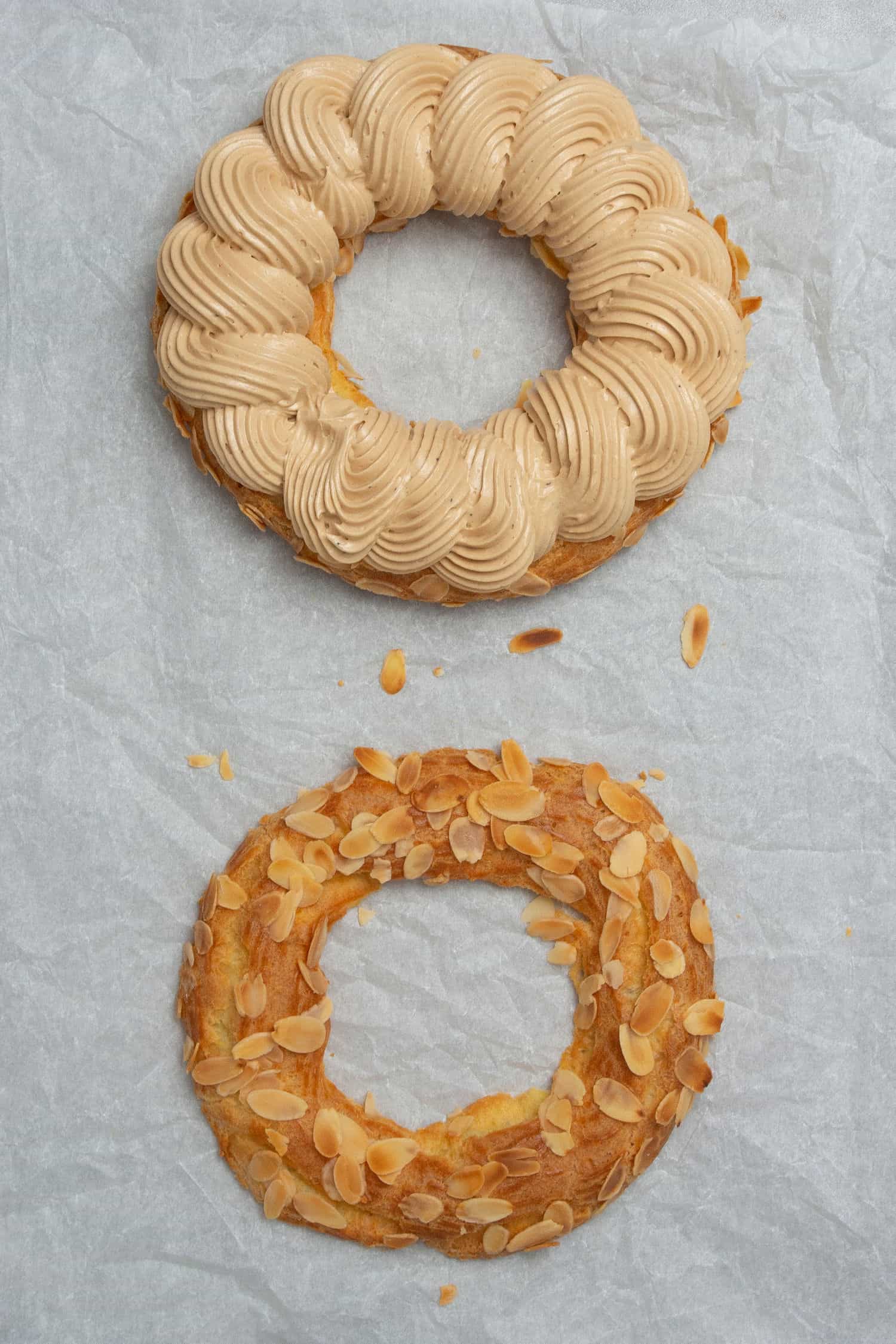
📝 Ingredient notes
For the choux pastry

- Milk: Whole milk is the best, definitely avoid using milk substitutes for this recipe unless you are aware of how to reformulate the recipe
- Sugar: This choux dough is made using granulated sugar. While heating the mixture up make sure sugar fully dissolves. If you want to learn about the different types of sugar and how to use them in baking, please read my sugar guide
- Water: The milk-water ratio in this Pâte à choux recipe is 50-50%. If you are more experienced, feel free to play around with different ratios
- Salt: An essential ingredient in most of dessert recipes. Salt balances the flavor and enhances other ingredients, in the choux pastry recipe it also contributes to the right texture
- Butter: Use always unsalted as you want to be in control of the quantity of the salt. I am using 82% fat content butter in all my recipes. While in most of the recipes butter needs to be at room temperature, this is an exception. Since butter will be heated with other ingredients over the stove, it is fine to use it straight out of the fridge
- Flour: Make sure to use high protein content bread flour to achieve that lovely huge air pocket. I am using a 12% protein content flour, and get very poor results with low protein pastry flours. It might not be called bread flour in your country, please search for the protein content on the bag and purchase the one that is recommended to make bread, pizza, etc. If you want to be a Pro when it comes to deciding what type of flour to use in your baking, please read my flour guide
- Egg: Room temperature as always. I will have special notes on the quantity of the egg at a later stage of this recipe
🛒 You’ll find detailed measurements for all Ingredients in the printable version of the Recipe Card at the bottom of this post
Hazelnut Praline Crème Mousseline
- Milk: Use high fat content milk, the highest you can get! It makes a huge difference when it comes to deepness of the taste
- Sugar: Simple, white granulated sugar is perfectly fine
- Egg: Some pastry cream recipes call for whole egg however I strongly advise using egg yolk only for the best texture and flavor. Perhaps try my pavlova recipe if you want to use up your egg whites? Another, maybe not so obvious note is that the color of your egg yolk will dictate the color of your pastry cream. Farm eggs make super yellow pastry cream, on the other hand, supermarket eggs are usually way paler
- Flour: Flour is one of the thickening agents in this pastry cream recipe, use All-purpose flour. No, it won’t taste like flour!
- Starch: Corn starch is the other thickening agent in the recipe, theoretically you could only use flour OR only starch however I prefer 50%-50%.
- Butter: Use unsalted as per above. Room temperature is key here. If too cold, it won’t incorporate properly. If too hot/liquid, it will make the pastry cream runny. We will use butter twice, first when making the pastry cream and then when making mousseline cream out of the pastry cream
- Hazelnut Praline Paste: What makes this Paris-Brest super delicious is the hazelnut praline paste used both in filling the choux, also in the mousseline cream. Hazelnut Praline is effectively a paste that consists 50% hazelnut and 50% sugar (caramel to be exact). I prefer buying the praline paste online but it can be easily made at home by mixing toasted hazelnut with hot dry caramel, letting the mixture cool and harden then blending them together with a food processor until it becomes a paste. Make sure that your blender is strong enough to make the praline paste, it is quite an effort for the mixer that is why I prefer to buy it ready made. I absolutely adore hazelnut praline paste, it is a sweet, nutty paste with a super deep flavor. Not too thick, not too thin, mixing it with chocolate or pastry cream can take it to the next level. If you decide to purchase it, make sure you buy pure praline paste that is 50% nut (typically hazelnut) and 50% sugar. The one I am using is Callebaut Hazelnut Praline paste, see picture below. An alternative to substitute hazelnut praline paste is hazelnut butter, either store bought or homemade hazelnut butter. However, since it does not contain sugar, you will need to increase the sugar for the pastry cream.
🛒 You’ll find detailed measurements for all Ingredients in the printable version of the Recipe Card at the bottom of this post
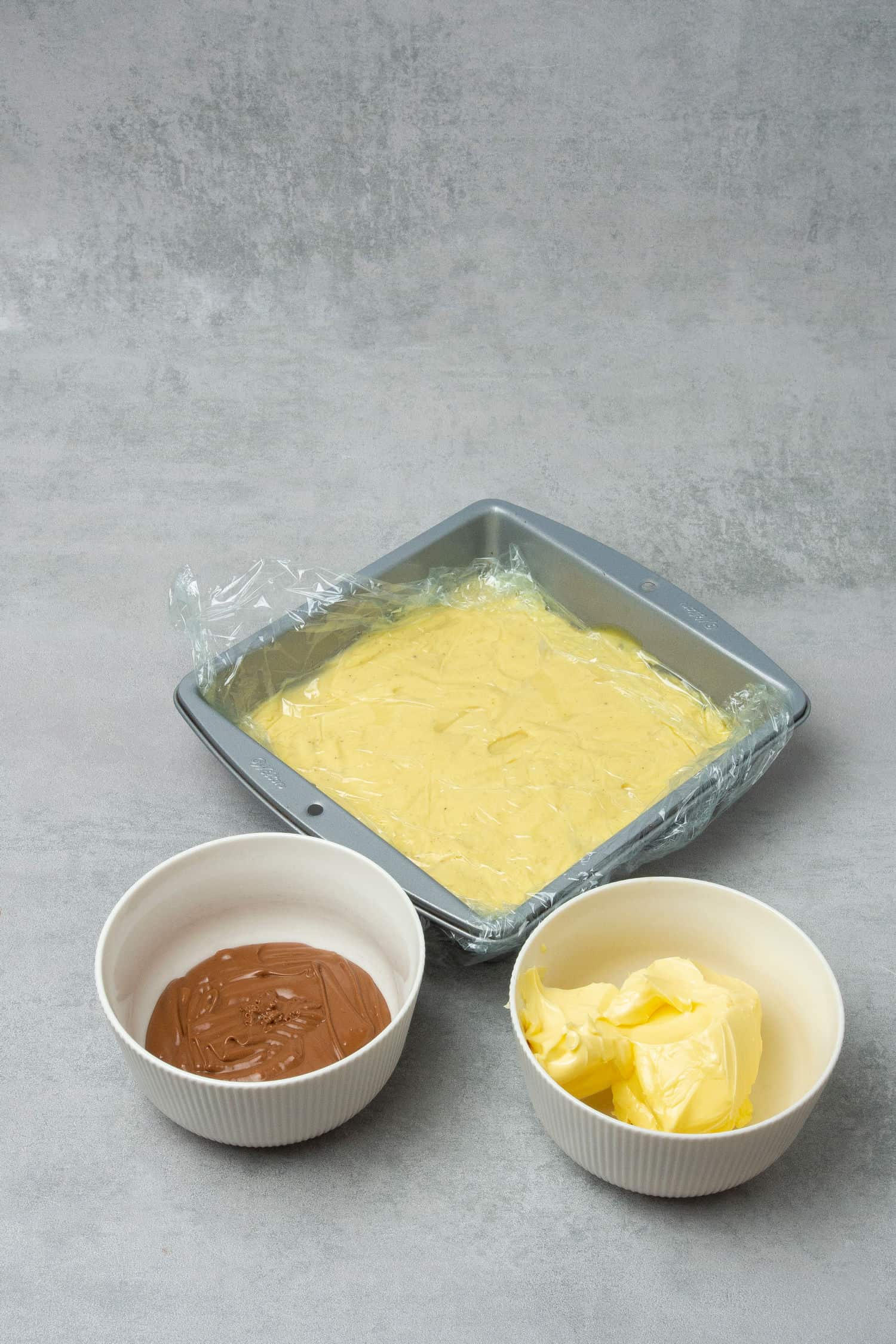
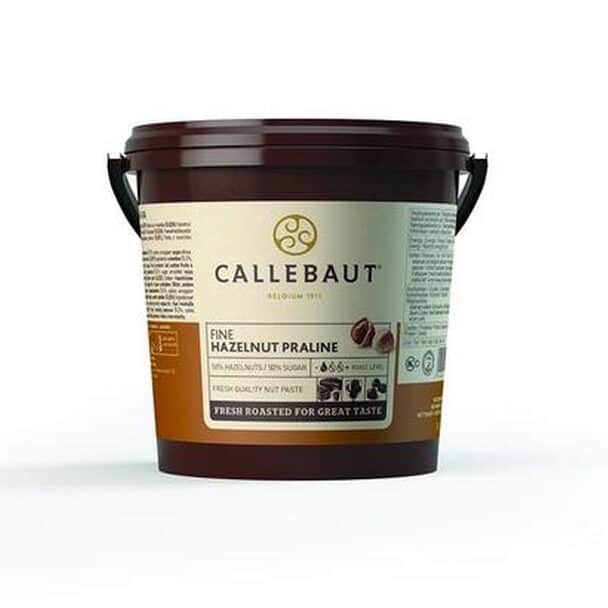
👩🍳 How to make this recipe
1. How to make Pâte à choux
I have a very detailed tutorial about Choux pastry in my eclair recipe. It contains tons of useful information about the choux dough, how to pipe it, how to bake it, what equipment is needed etc. I even have a Troubleshooting guide in case something goes wrong, make sure you check it out.
Making any choux pastry whether it is Paris-Brest, eclair, cream puff, profiterole, or choux au craquelin starts with a cooking process. The choux dough is not the type of dough where you can add a bit of this, a bit of that at a later stage, the steps and their order in the recipe are strict therefore make sure you follow them.
- The choux dough is a cooked dough which means the butter, milk, water mixture the so-called first needs to be heated until simmering
- Add the flour and cook the dough (the so-called panade) for a few minutes (2-3minutes) over medium heat mixing constantly
- The cooking process of the panade is ready when some moisture evaporates from the dough and by then there should be a thin skin formed on the bottom of the saucepan.
💡 Top Tip: Make sure, you sift flour before adding it to the mixture as you want to avoid lumps
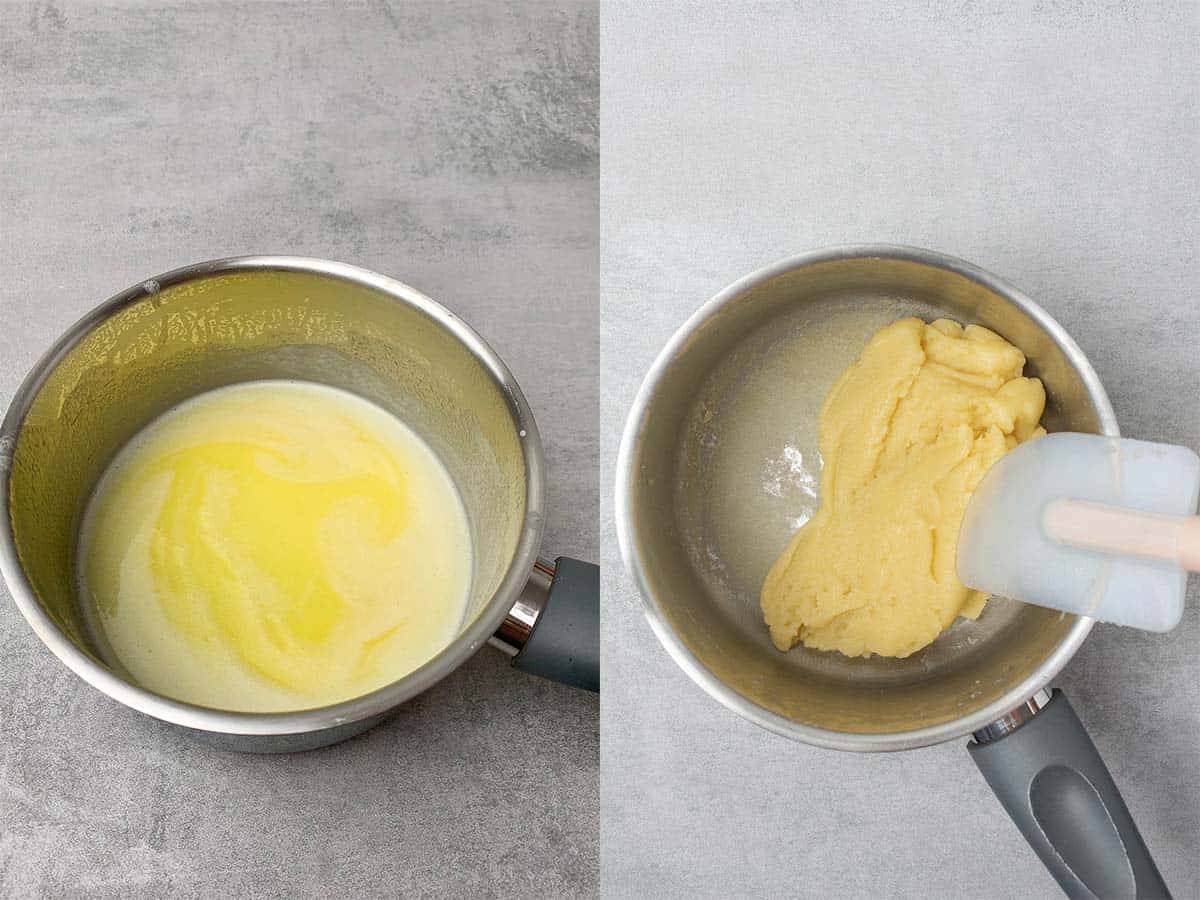
Mixing the egg in will need somewhat your judgment. Only add a small amount of egg at a time, consistently whisking after each addition. I am using the paddle attachment on my stand mixer, alternatively, this can be also done with an Electic Hand mixer but pay close attention to the consistency of the dough. First, the mixture might separate but keep your mixer on, and the dough will come together and should reach a glossy, pipeable consistency.
Please note, that depending on the flour you use and how much you “dried” the mixture at the cooking stage, you might need to use slightly more or less egg than stated in the recipe. Very important that you can not add more flour to the mixture at this late stage, so while adding the egg into the mixture check the dough consistency regularly, and if you accidentally add more egg and the dough is too runny, start again.
💡 Top Tip: Apply the “V test”: the dough is ready when it slowly falls down from the paddle attachment in a V shape. Slowly is key here, it should not be too runny, or you might find it difficult to pipe

2. How to pipe the ring shape
As mentioned above, while mixing the egg in you have to take into consideration to mix in as much egg to get a shiny, pipeable consistency. The mixture should not be too firm, nor too runny.
Move the dough into a pastry bag fitted with French star nozzle tip. You can also use a round nozzle tip but very likely that you won´t get a burst-free result with that. It is also important to get rid of any air bubbles before piping. You can achieve this by moving the dough into the piping bag in one go, as well as pressing the air pockets out of the piping bag with your hands before piping.
Now at this point, I suggest leaving the dough in the fridge for 1-2h – this helps to achieve even baking later without major cracks on the surface.
Then, dump a cookie cutter into powder sugar then tap it onto the Perforated “air” baking mat - these circles will help you while piping. Pipe 2 ring shapes next to each other so the choux dough touching each other, and one on top. Piping will take practice, if you are unhappy with the result, you can always move the dough back to the piping bag and start again.
Ideally, pipe the choux pastry onto Perforated “air” baking mat that provides even baking due to air circulation through the mat. Try to pipe evenly while holding the piping bag vertically. Alternatively, pipe the choux dough onto a baking sheet using a large tray. I don´t recommend using a silicone baking mat for making choux pastry as my experience is that choux somewhat gets wet from the bottom during baking. I suggest ideally Perforated “air” baking mat or parchment paper.
Then, cover the entire surface of the choux dough with roasted almond slices - again this will help the choux to bake evenly without bursting all over the surface.
Please note that the recipe makes 3 Paris-Brest about 19 cm / 7.5 inches in diameter each. Since the choux will expand in the oven, you will need to pipe about 14 cm / 5.5 inches.
💡 Top Tip: Before baking, you will have to freezer the choux rings. Why? For a neat, even baking! You can also store the unbaked Paris-Brest in the freezer for a few weeks
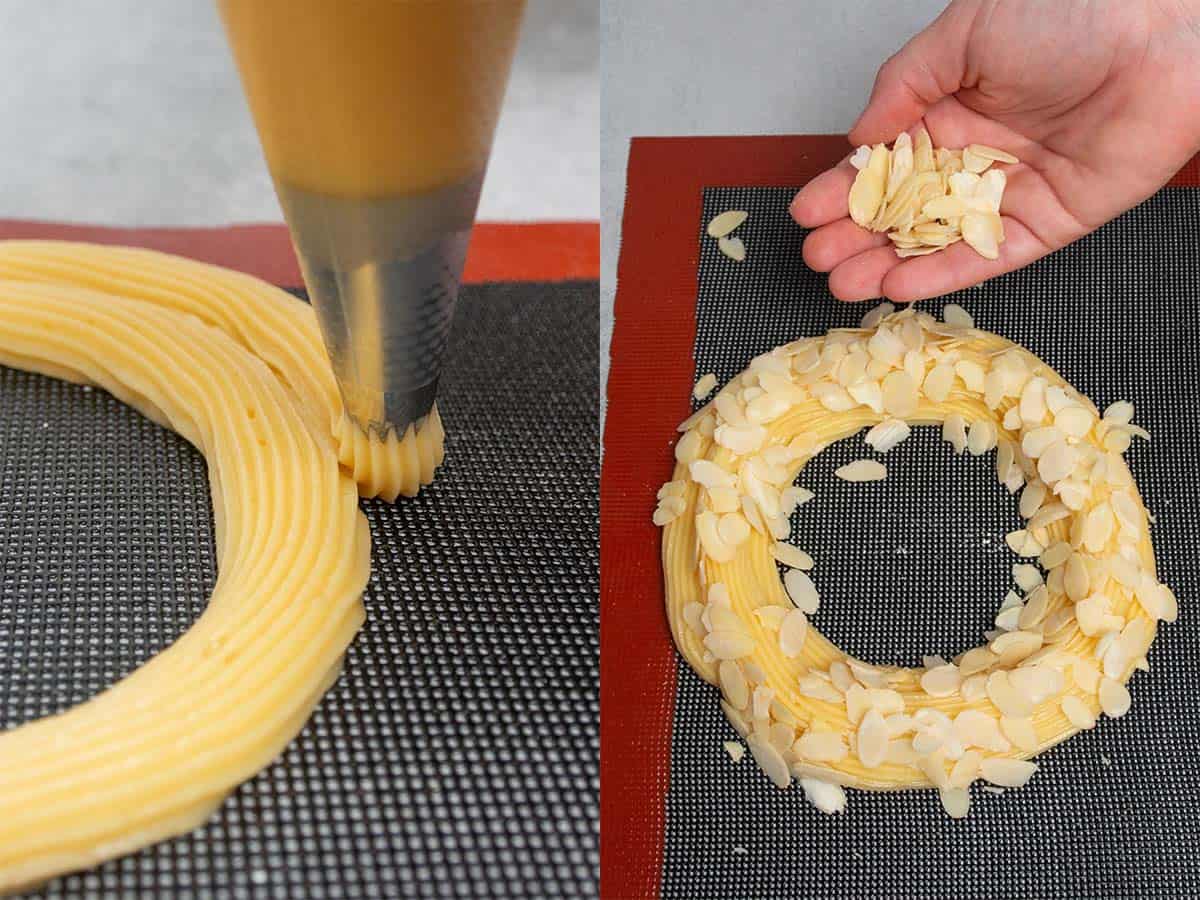
3. How to bake
Some suggest starting with a high baking temperature, then decreasing for the second half of the baking time. I find even baking temperature works better, supports more even baking. Having said that, I suggest to pre-heat the oven to a higher temperature (200 C / 392 F no fan) then decreasing it later, please see instructions in the recipe. Feel free to experiment with your own oven!
It is very important that you use a Digital oven thermometer that states the correct oven temperature. I personally do not bake without my oven thermometer on, and if your oven is over or under run 10C / 50F (that is very common), then it will be impossible to follow this recipe and get the same result.
I bake the choux for 40 minutes at 170 C / 338 F (no fan), but you need to test and try your own oven. It is a good idea to take one out at 40 min, wait for a minute to see whether it collapses, if not, very likely that it is well baked. Overall, I suggest starting with my baking suggestions however each oven is different, you have to find what works best for you.
Once choux pastry is well baked, let it cool on the mat.
💡 Top Tip: Do not open the oven door in the first 30 minutes under any circumstances as the choux might collapse
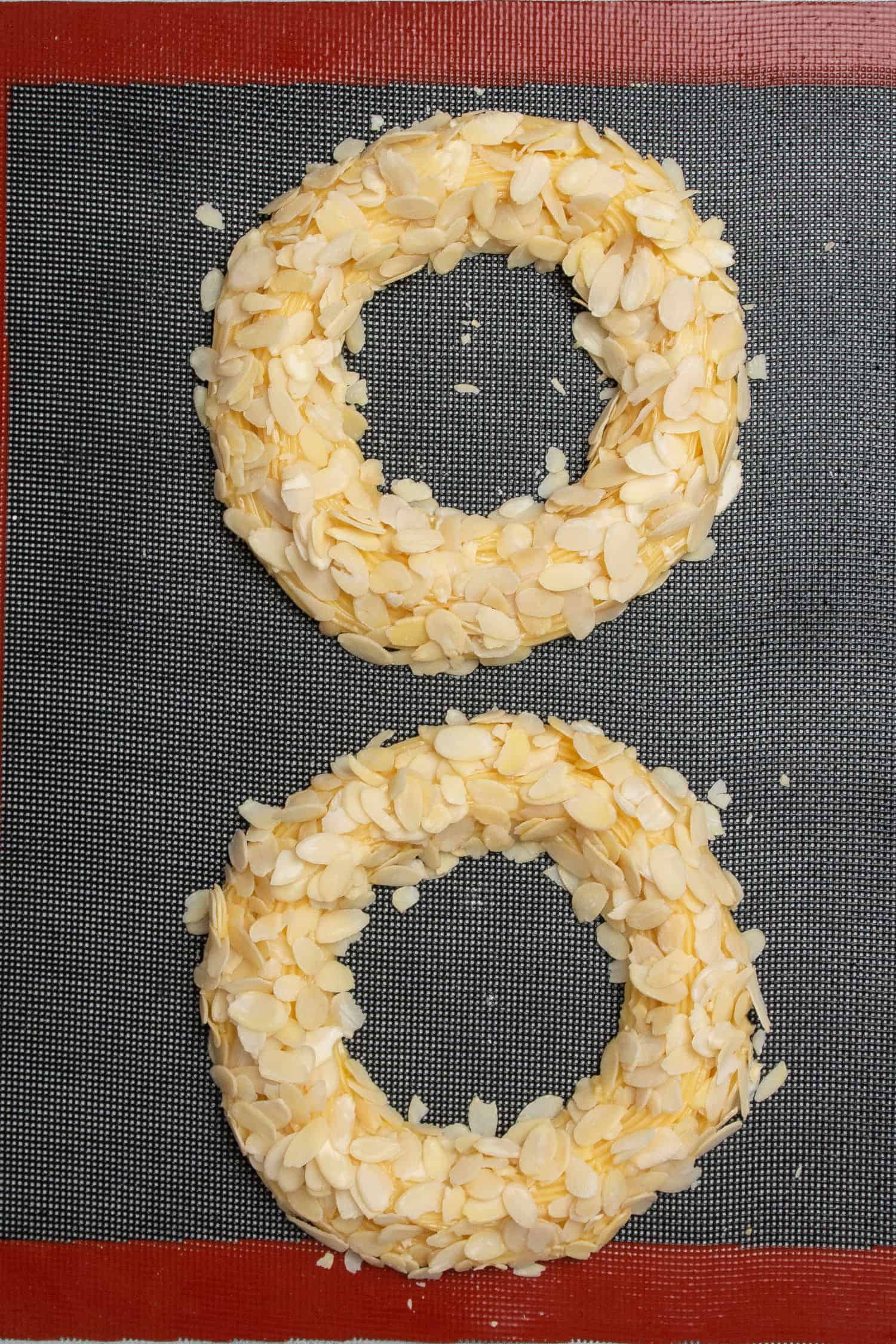
4. How to make pastry cream for the Hazelnut Praline Crème mousseline
Pastry cream is the most delicious rich, silky and creamy custard-like cream filling used in many types of desserts. You will have to make a pastry cream first that will be turned into Crème mousseline at a later stage with fluffy, soft butter. I have a whole detailed Baking Guide with tons of tips about making the perfect pastry cream (Creme Patissiere), make sure you read it.
- In a large enough bowl with the help of a Hand whisk, whip together sugar and egg yolk until slightly fluffy for about 1-2 minutes
- Mix in corn starch, flour, and vanilla until thoroughly incorporated and have a smooth paste
- Bring milk to boil in a saucepan on medium heat then remove it as soon as it starts simmering. Make sure it is simmering but not crazy boiling
- Pour the warm milk over the egg yolk mixture slowly while whisking vigorously with a Hand whisk. This stage is effectively tempering the egg yolks and the mixture should already start to slightly thicken
- Pour the mixture back into the saucepan and cook on medium heat for a few minutes until it thickens. Concretely it is approximately 1 min after the first boil. It might get lumpy first, don’t worry just keep whisking and the cream will get smooth and glossy. It’s worth keeping a good quality (so that the milk won’t burn in it) small/medium-sized saucepan for making pastry cream only
- If in doubt, strain the pastry cream for a lump-free, creamy end result
- Add in room temperature soft butter and mix with a Rubber spatula until completely incorporated. It is worth adding the butter in 3 stages and mixing well after each addition
💡 Top Tip: Pastry cream needs to be completely cooled to room temperature before using it to make the filling for the Paris-Brest. Place the cream into a shallow bowl or container and cover the entire surface with plastic wrap to avoid a skin forming on top
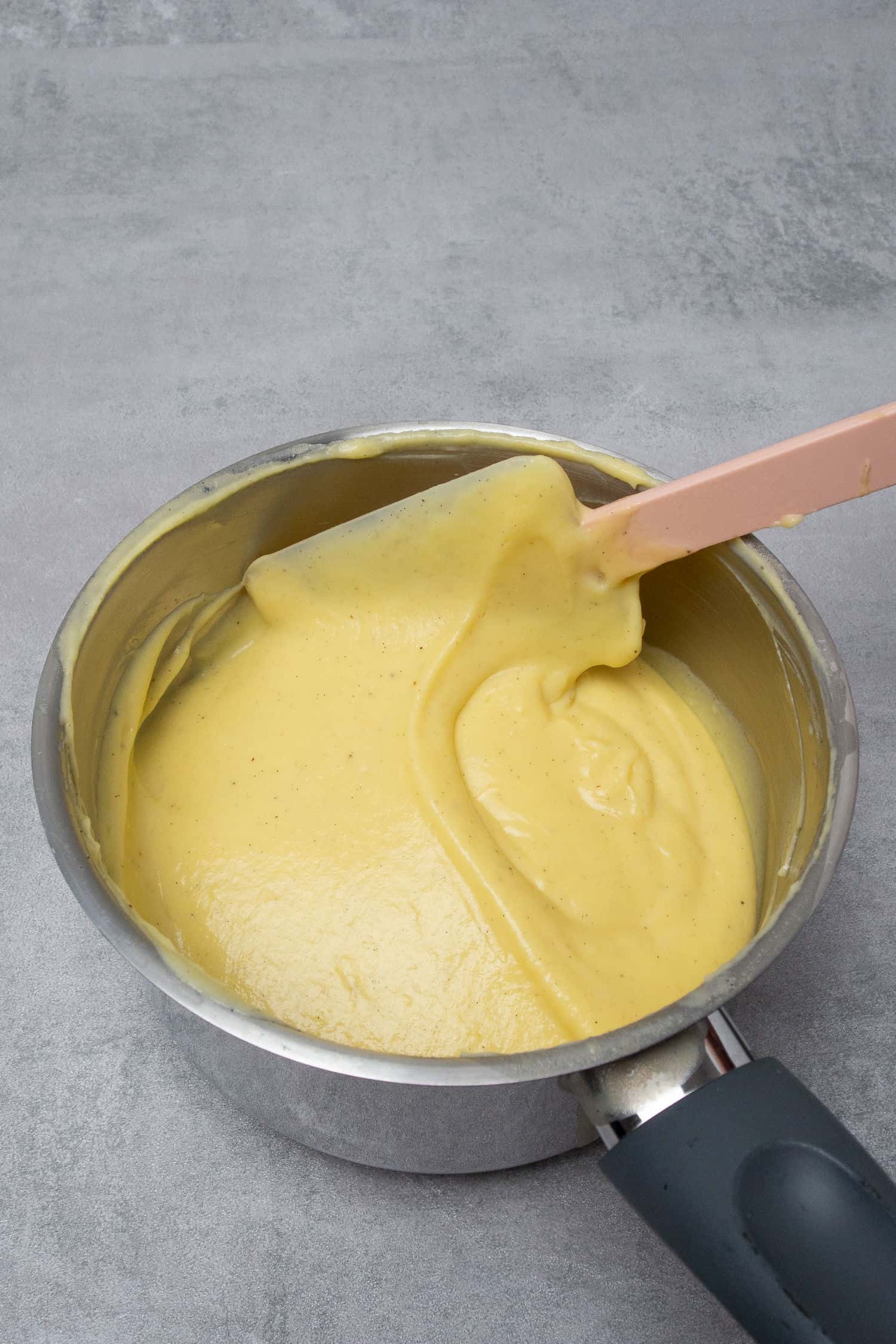
5. The process of making Hazelnut Praline Crème mousseline
This Paris-Brest filling is a rich, but not overly sweet cream, and very stable to pipe or to fill cakes.
The process is simple, however, you have to be careful with the temperature of the ingredients:
- It is very important that the pastry cream is cooled but not cold meaning either let it cool at room temp or cool it in the fridge then let it come back to room temperature
- The butter needs to be soft. Soft butter means soft enough without hard butter chunks for the mixer to cream it but do not melt it in the microwave as melted butter can´t be creamed
- So once pastry cream is set but not cold and butter is soft, move butter into your Stand mixer fitted with your whisk attachment and start creaming the butter for a few minutes until it becomes fluffy. Alternatively, this can be also done with an Electic Hand mixer but pay close attention to the consistency of the cream
- Once butter is creamy and pale, add praline paste and whip until combined
- Then, start adding the room temperature pastry cream in 4 steps (adding always ¼ only) while the mixer is still on
- Cream mixture until it reached a fluffy, pipeable consistency. This will take about 1-2 minutes
- Make sure you do not over whip the cream at this point as it can get runny
Please note that due to the butter content mousseline cream at this point might be on the soft side, if so, chill it for an hour before piping. However, do not fully chill it for hours as the cream gets firmer in the fridge over time and you might find it difficult to pipe.
💡 Top Tip: Room temperature is key while making mousseline cream. If either pastry cream or butter is too cold or too warm, you won´t be able to whip up the mixture properly as either butter will stay in chunks or the entire mixture will break and curdle
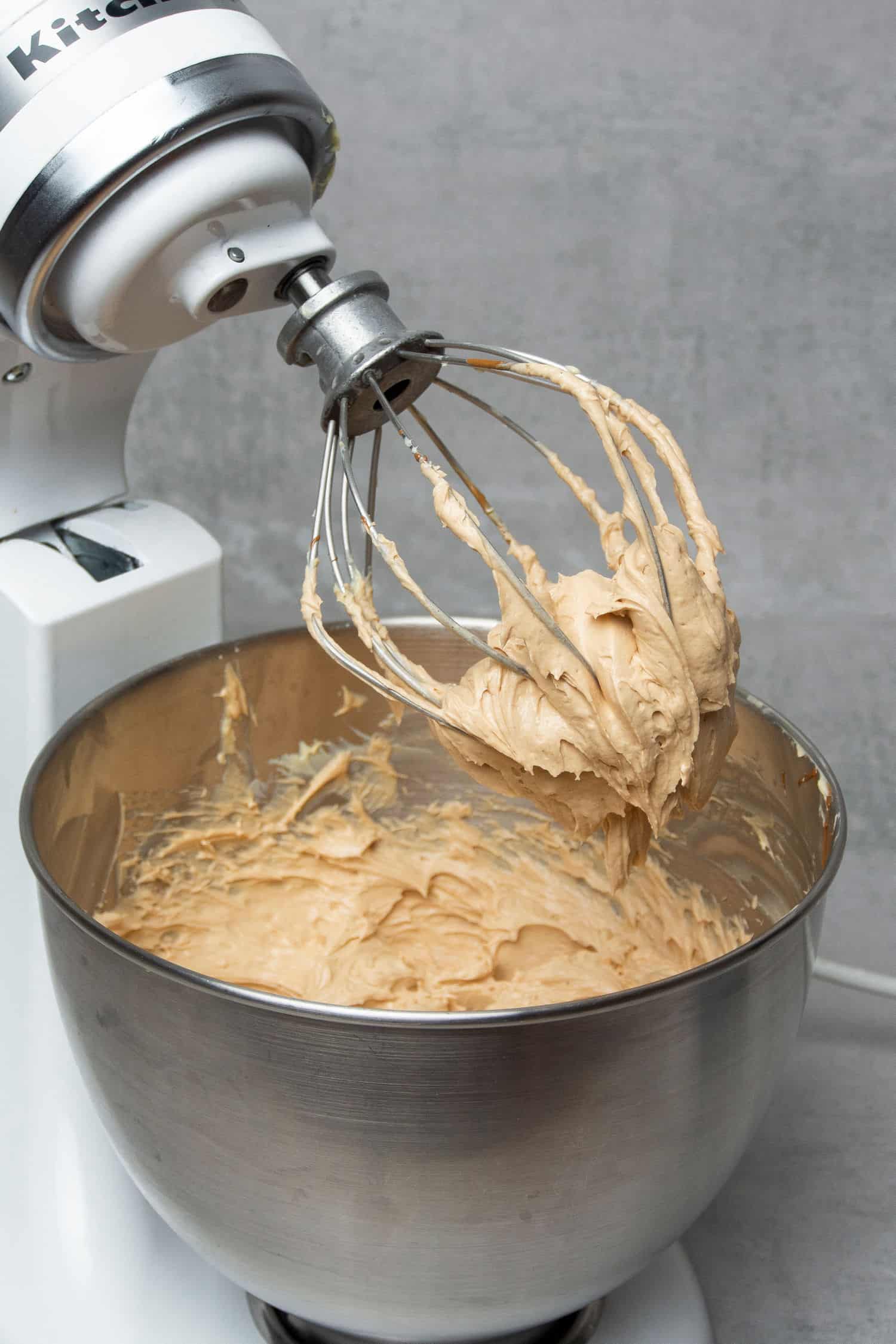
6. How to assemble the Paris-Brest
I recommend making the pastry cream first and letting it come to room temp. In the meantime, bake the choux pastry rings. After, prepare the hazelnut mousseline cream. Once choux rings and also the Hazelnut Praline mousseline cream is ready, assemble the Paris Brest as per below:
- Cut the top of each choux ring
- Fill the bottom of the choux ring with chopped roasted hazelnut all around, about one tablespoon per ring
- Pipe some hazelnut praline paste on top of the roasted hazelnuts, as per the picture below
- Move the freshly whipped mousseline cream into a piping bag fitted with a nozzle tip. You can use Wilton 1M piping nozzle tip or French star nozzle tip
- Pipe the hazelnut praline mousseline cream around the choux
- Dust the top part of the choux ring with icing sugar and place it on top
- Decorate the top with some more hazelnut and hazelnut skin
Voila, your Paris-Brest is ready, it will certainly impress all your family and friends!
💡 Top Tip: Please note that due to the butter content mousseline cream at this point might be on the soft side, if so, chill it for an hour before piping. However, do not fully chill it for hours as the cream gets firmer in the fridge over time and you might find it difficult to pipe.
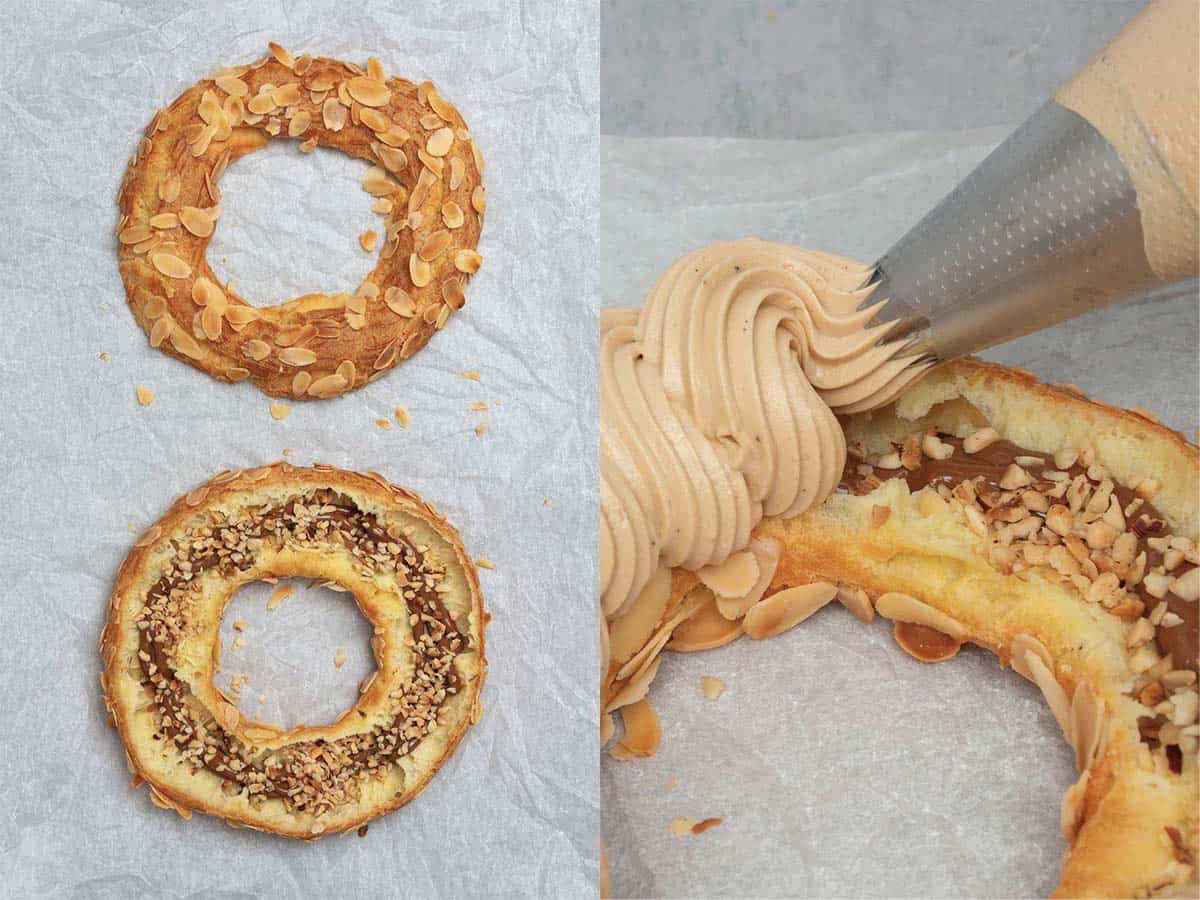
🥣 Equipment notes
Perforated baking “air” mat for even baking
I have been using Perforated “air” baking mat for more than a year now from a brand called Silikomart and love it. I use it all the time for baking tarts, choux, and even for cookies. Thanks to the holes in the mat, the heat spreads evenly throughout the mat’s surface guaranteeing a perfect and even baking. Use the Perforated “air” baking mat on top of the oven rack so that the air can circulate properly. If you do not own this wonderful baking equipment it´s worth considering investing in it. Alternatively, lining a baking tray with a baking sheet can work too, it is just neater and less risky with Perforated “air” baking mat.
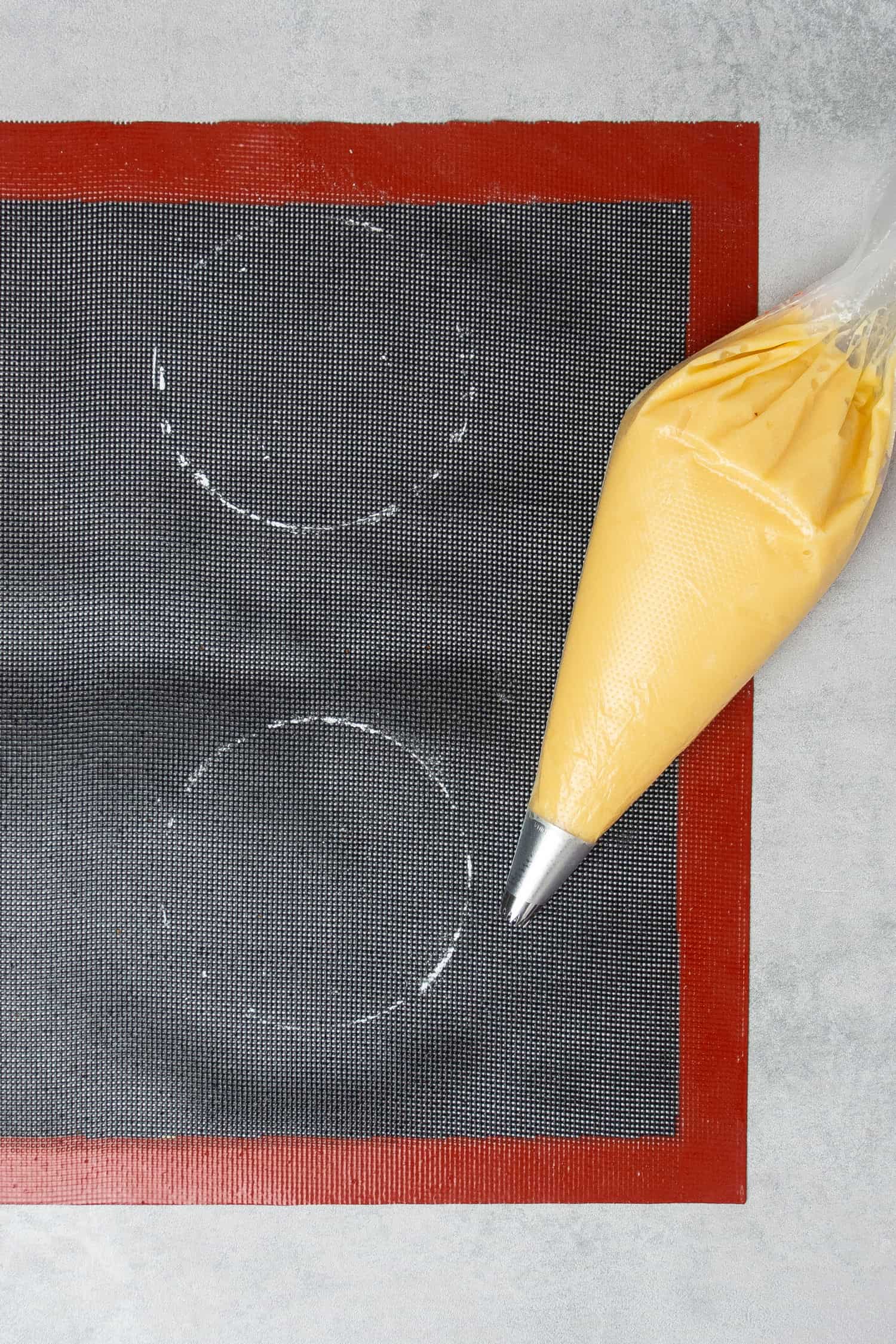
Stand mixer
Whipping the mousseline cream theoretically can be done with an Electric hand mixer, however, it is much safer to whip it in a Stand mixer using the whisk attachment. Especially if you are making 2-3 Paris-Brest desserts at the same time, a stand mixer is much more reliable and comfortable.
French star nozzle tip
As mentioned above a Wilton 6b French star nozzle tip is one of those super cheap and easy investments that can make or break your choux pastry recipe whether you are making Paris-Brest or eclair. If you want to max your chance of a neat, burst-free choux baking, I definitely recommend using a pastry bag fitted with a star nozzle tip.
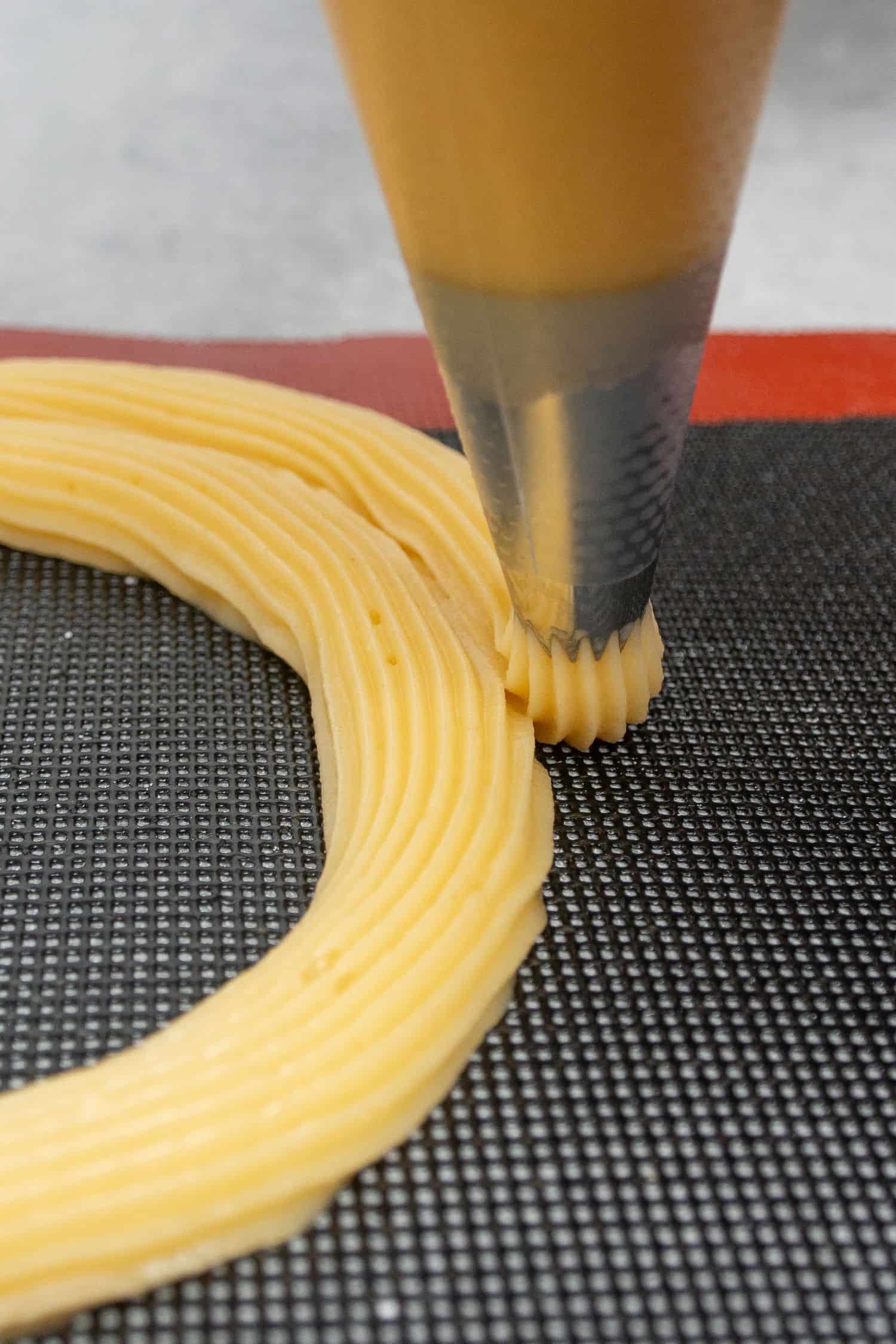
🎓 Expert tips
- While making choux pastry, the most critical part is mixing the egg in. Make sure you do it step-by-step, regularly checking the dough consistency, and stop adding the eggs as soon as passed the V shape test
- While mixing the egg into the pate choux dough, the egg should be at room temperature and pre-whisked
- Have you ever experienced choux collapsing after baking? A digital oven thermometer will be your best friend while making choux pastry, an inexpensive kitchen tool to ensure the correct baking temperature
- When making the mousseline cream, the temperature is critical. Both pastry cream, as well as butter, must be at room temperature
- Hazelnut praline can be easily substituted in the recipe with 100% hazelnut paste or pistachio paste, even peanut butter or Nutella, but make sure to adjust the sugar accordingly
❓Recipe FAQs
Yes of course you can, this recipe works no matter what size you want to bake, however, you will need to adjust the baking time and ingredients accordingly
Yes, most probably you can, however, you can´t just replace flour with gluten-free flour 1:1 without reformulating the recipe. When one ingredient changes, some other ingredients need to be changed too in order to keep the balance in the texture and flavor
Not very likely since the rise of the choux is supported by the egg itself
Sounds like your dough is too wet, mix in fewer eggs next time. Please note, that you cannot add extra flour at this stage, you will want to start the process all over again
Most likely it was not baked well, either because you have taken it out too soon, or maybe your oven under-heat. Bake them longer next time
Paris-Brest is traditionally a hazelnut flavored dessert made with praline paste that is 50% sugar (caramel) and 50% hazelnut -so I would say try not to substitute it. If you can´t access hazelnut praline paste, you can try to use 100% pistachio butter or 100% hazelnut butter instead, but increase the sugar content in the pastry cream. Or, you can make the cream with Nutella too, check my Ferrero Rocher cake for detailed instructions
You have to start with a pastry cream that is stable. Then, you will want to follow my tips about how to properly whip this kind of cream with the butter without the cream curdling. Just like making most other kinds of frosting, the temperature is key and most important is that you do not overwhip the mixture. Make sure that you stop whipping as soon as the mixture is fluffy and pipeable, as a minute later it will break and become runny. If the cream is not runny but more on the soft side, don´t worry, it will set in the fridge
Once you assemble the Paris-Brest, it should be served immediately, or within a few hours, as choux pastry tends to get soggy from the filling, which is normal. Leftover - if there is any - should be stored in the fridge for 1 day in an air-tight container.
Mousseline cream does not freeze well and might break. However, you can freeze the choux pastry before baking. The baked choux ring can also be frozen however the crispiness might lose a bit after thawing
✨ More Choux pastry recipes
🔥 Join my Ferrero Rocher inspired Paris-Brest dessert Online Baking Class
If you want to try the most delicious combination of my Ferrero Rocher cake and this Paris-Brest dessert, you must sign up for my Online baking class where I will teach you how to make the most amazing Ferrero Rocher-inspired Paris-Brest dessert! Live and Pre-recorded Classes are available, do not miss this opportunity!
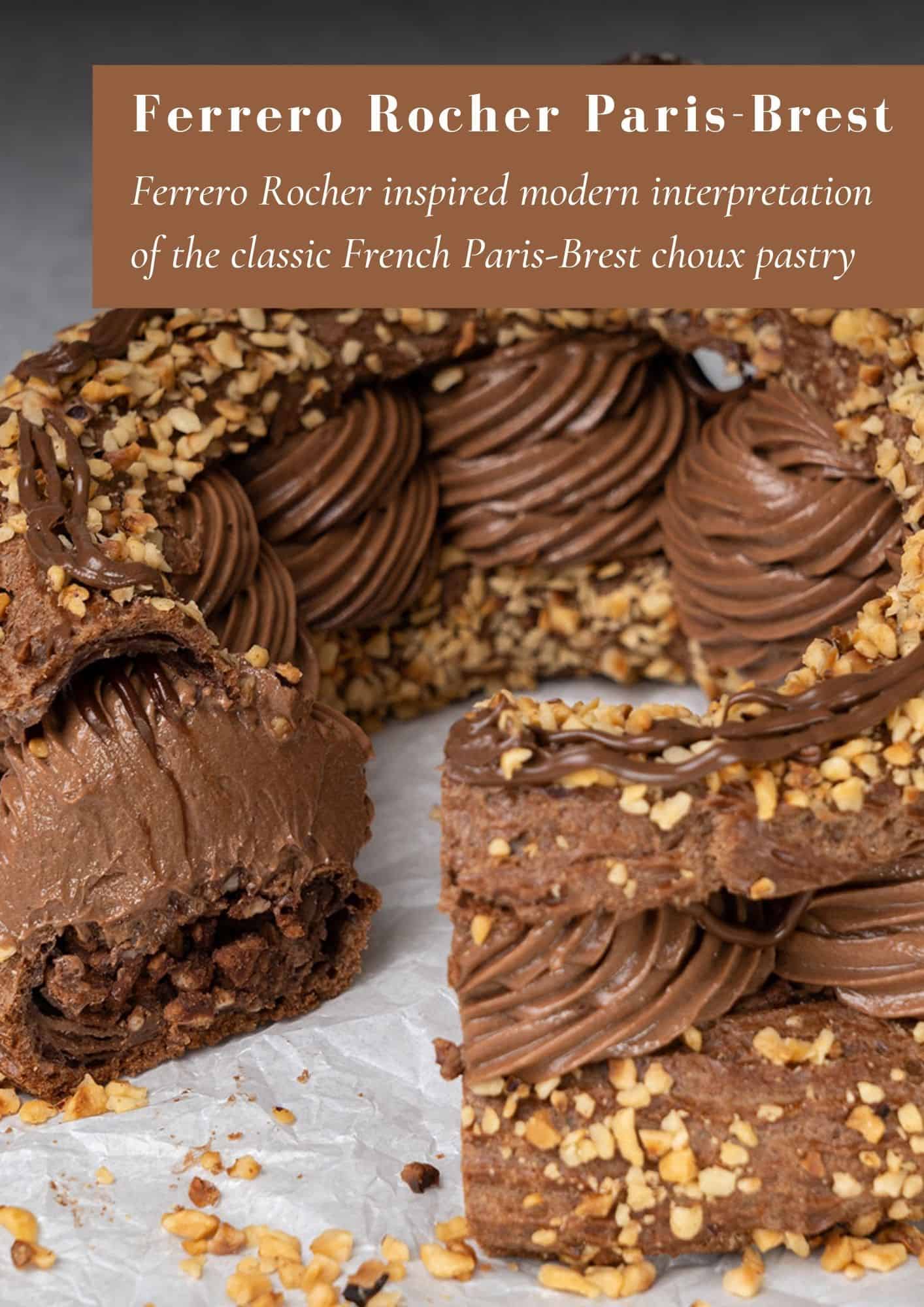

ULTIMATE Paris-Brest (VIDEO)
Equipment
Ingredients
For the choux pastry
- 120 g (½ cups) Unsalted butter 82% fat content
- 120 g (½ cups) Water
- 120 g (½ cups) Whole milk
- 2 Large pinch of salt
- 1 Tablespoon Granulated sugar
- 140 g (1 cups) Bread flour high protein flour (12% protein)
- 220 g (1 cups) Egg might need slightly more or less, pls see tips above
- 75 g (½ cups) Almond flake
For the Praline Crème Mousseline
- 500 g (2 cups) Whole milk
- 100 g (½ cups) Granulated sugar
- 80 g (⅓ cups) Egg yolk approx. yolk of 4-5 eggs
- 25 g (⅕ cups) Corn starch
- 25 g (⅕ cups) AP flour
- 2 teaspoon Vanilla bean paste
- 50 g (¼ cups) Unsalted butter room temperature, 82% fat content - will be used while making the pastry cream
- 130 g (1 cups) Hazelnut Praline paste homemade or store bough
- 150 g (⅔ cups) Unsalted butter room temperature, 82% fat content - will be used while making the mousseline cream
For Assembling
- 3 tablespoon roasted chopped hazelnuts
- Hazelnut praline paste homemade or store bough
US customary cup measurement is an indicative figure only. Measure the ingredients with a digital scale by weight (gram). Baking is art but also science which requires precision and accuracy.
Instructions
Choux rings
- Sift flour then measure and set aside
- Place butter, water, milk, salt and sugar into a saucepan over medium heat
- As soon as the mixture starts to boil remove from heat, add the flour in one go, and whisk vigorously with a Rubber spatula until it forms one smooth ball and flour bits are not visible
- Place the saucepan back to the stove and cook the dough for about 3 min over medium heat mixing constantly. It is ready when a sort of skin forms on the bottom up the saucepan
- Transfer the dough into a bowl and let it cool down slightly before mixing the egg in. Mix in only a small amount of egg at a time, consistently whisking after each addition. You should reach a consistency which is not too runny, not too firm but just fine to pipe. Pls see tips above
- Move choux dough into a piping bag fitted with French star nozzle tip and let the dough rest in the fridge 1-2h
- The recipe makes 3 Paris Brest 19 cm / 7.5 inches in diameter. Since the choux will expand in the oven, you will need to pipe about 14 cm / 5.5 inches
- Pipe the dough in ring shape, leaving enough space in between them, as they will puff, then place the tray into the freezer for min 1h. Use Perforated “air” baking mat or baking paper.
- Pre-heat oven to 200 C / 392 F
- Lower oven temperature to 170 C / 338 F and bake the Choux rings for 40 min. Do not open the oven door in the first 30 min. If you are baking it the first time it is a good idea to take one choux bun out of the oven at 40 min and check its consistency. If it is golden in colour, nicely puffed up, does not deflate on room temperature and the middle of the ring is not raw (it is ok if it's a bit wet, it will dry while cooling down) then it is considered to be done
- Cool them either on the perforated air mat or if baked on parchment papaer, then cool them on cooling rack
Pastry cream
- In a large enough bowl with the help of a Hand whisk, mix together sugar and egg yolk until slightly fluffy for about 1-2 minutes
- Mix in corn starch, flour, and vanilla until throughly incorporated and have a smooth paste
- Bring milk to simmering in a saucepan on medium heat. Make sure it is simmering but not crazy boiling, see my tips above
- Pour the warm milk over the egg yolk mixture slowly while whisking vigorously with a Hand whisk.
- Pour the mixture back into the saucepan and cook on medium heat for a few minutes until it thickens. Concretely it is approximately 1 min after the first boil. It might get lumpy first, don't worry just keep whisking and the cream will get smooth and glossy
- If in doubt, strain the pastry cream for a lump-free, creamy end result
- Add in room temperature soft butter and mix with a Rubber spatula until completely incorporated. It is worth to add the butter in 3 stages and mix well after each addition
- Place the cream into a shallow bowl and cover the entire surface with plastic wrap to avoid skin forming on top. Let it cool to room temperature
Make the mousseline cream
- Crème mousseline can be made with room temp pastry cream, room temp butter, and hazelnut praline paste. Make sure everything is at room temp otherwise the mixture might curdle
- Whipp room temp butter first for 1-2 minutes, then mix in praline paste
- Start adding in the room temp pastry cream in 4 stages until cream reaches a stable yet fluffy texture. Do not over whip the mixture as it can become runny
Assemble
- Cut the top of each choux ring and fill them with about 1 tablespoon chopped roasted hazelnut per ring plus some hazelnut praline paste on top
- Dust the top part of the choux ring with icing sugar and place on top. Decorate the top with some more hazelnut and hazelnut skin
- Store in fridge. Paris Brest is best served fresh as choux pastry might get soggy after some time. Due to the butter content mousseline cream will get firmer in the fridge, that is normal
Notes
- Measure your ingredients with a Digital scale for accuracy
- To make the choux, use high protein content bread flour for the best results, I am using 12% protein content flour
- Do not skip the salt, it has a special function while baking choux
- For the mousseline cream use whole milk and hazelnut praline paste
- Feel free to substitute the hazelnut praline with hazelnut butter but make sure to increase the sugar content for the pastry cream and hazelnut butter contains no sugar
- Make sure you read my Expert tips section above to maximize your success. A short recipe alone is not able to cover all the necessary details, and science behind baking
- While heating the milk, water, butter, salt, sugar mixture make sure that sugar and salt fully dissolves
- Do not skip sifting flour as you don´t want to deal with flour lumps while making this recipe
- Please note that you might need slightly more or less egg - and that is normal - depending on the flour you use and how much you dried the mixture while cooking it. Pay very close attention to the consistency while mixing the egg in and apply the V shape test.
- There are 2 chilling times involved - one fridge resting before piping, and one freezing before baking. Both of them are important to achieve neat, crack-free results
- Use a star nozzle tip so your choux pastry will puff neat
- If you have never used a piping bag and piping nozzle before, it is worth practicing before
- I strongly advise using a Digital oven thermometer to be able to measure your exact oven temperature
- While baking, do not use fan in your oven, it can encourage cracks on your eclairs
- While making Creme mousseline, it is crucial that both the pastry cream as well as the butter is at room temperature. Also, make sure you do not over whip it as it can become runny

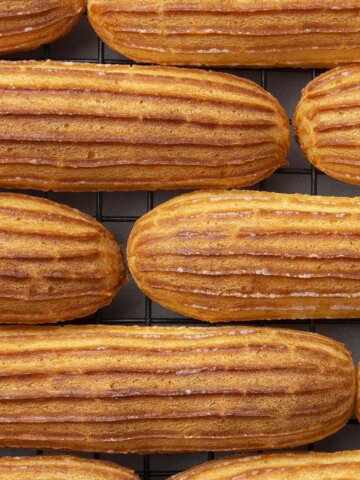
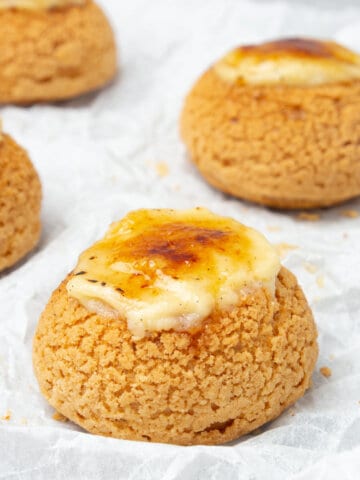
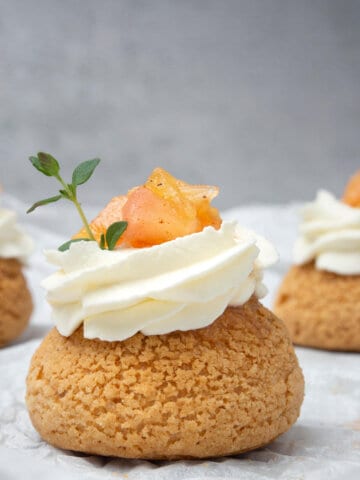

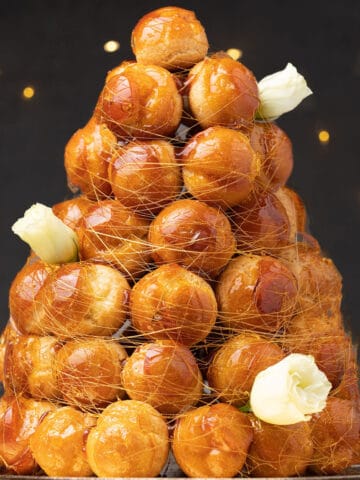

Weronika
Fantastic recipe - full of useful tips! Everyone loved it! Thank you 🙂
Kata
So happy for you! It is also one of my fav recipes:)
Bruce
This review is for Kata's Paris Brest live baking class. Kata has a natural. enthusiasm and passion that show through. She is detailed, focused and answers questions along with checking our work via the ZOOM meeting. I'm very glad I took this class and learned a lot. Who knew you could freeze pate choux before baking? I tried it since the class with cream puffs and it worked beautifully--thanks Kata!
Kata
Thanks for your kind feedback Bruce, it was such a pleasure to e-meet you from my kitchen and I am so happy that you enjoyed the Paris-Brest class!
Vesna
I tried couple of other Paris Brest recipes and my choux pastry was never good but with this recipe everything turned out perfect! I think your tip with fridge and freezer really makes a difference. The cream is heavenly! I did try both options, making my own praline and buying, both were good but homemade one wins! I love your recipes!
Kata
I am so happy for your success, hope you will try some of my other recipes as well soon:)
Katie
Hi Kata,
It's said to rest the dough in the fridge for a couple of hours before piping and rest another 1 hour in the freezer after piping, I was wondering if it could stay in the fridge/freezer a bit longer than that? Thanks!
Kata
Hey, fridge no, freezer yes, even for weeks:) Good luck, let me know how it turns out!
Linda Kirkland
I am anxious to make this as I love working with choux but I cannot find hazelnut praline paste on line. Can you tell me where to get it in quantities under 10 pounds?
Kata
Hey it is difficult to recommend a brand or product as my Readers live all around the world. If you cannot find it in your country, you can either consider making it from scratch (it is not difficult but require a good quality processor), or use simple hazelnut butter. Since hazelnut butter is 100% hazelnut, while hazelnut praline is 50% hazelnut 50% sugar, I suggest increasing the sugar in the pastry cream to balance the sweetness. Let me know how it goes:)
Robin
Hi Linda! I found some online in a 12oz jar at cocoläat.com.
Magdalena
I made Paris Brest for the very first time in my life this year following every single step in your recipe and it was such a hit 🙂 Made it for my mom´s b-day. Everybody loved it. It turned out excellent. Looked perfect, tasted super delishhh. Thank you so much for your time dedicated to every detail of your recipe here. Can´t wait to give a go to more recipes of yours! 🙂
Ob
Hello Kata. I have made these twice (today being my third) and the eclairs my fourth (today being my fifth). Your recipe is out of this world. Perfection. Just a quick question., If I were to use half this recipe and make eclairs how much mouselline would it make? I tried to figure this out in the last bath that I did but the mouselline was a bit wet (not too much) but it didn’t hold its shape whilst being piped. Would greatly appreciate your feedback as I’m making in the next couple of hours for Sunday brunch! Thank you!!!!
Kata
Hey, not sure I understand your question, do you want to bake eclairs and fill them with the hazelnut mousseline cream? It is not really possible to give exact quantity bec eclairs will hold less filling than the Paris-Brest. I would say if you half the Paris-Brest recipe and want to fill it with mousseline cream, maybe you need to third the cream - just as an estimation.
Ann
I recently made this and it was amazing. Every single step of the recipe turned out great and that really doesn’t happen a lot in pastry recipes. The end result was just as good as pretty. A wonderfull dessert.
Kata
I am so happy to hear that my recipe turned out well for you! Hope you will try some of my other recipes as well soon:)
Susan
The TIPS were so valuable. My other receipe pastry was a disaster! Using sifted pastry flour instead of regular made a huge difference. Thank you
Sylvie
Choux pastries have always intimidated me and I have never managed to bake them to perfection. Until today that is 😀
Many novice bakers might find overwhelming the amount of information on this page but it’s a wealth of information that’s there for a purpose and that just cannot be skipped. I referred to it several times and it felt to me like having someone guiding me personally through the different stages of the recipe.
Kata
I am so happy that you found my instructions helpful! Hope you will try some of my other choux pastries as well soon, look forward to seeing your creations on Instagram:)
Wiadomości
Czytam i czytam oczom nie wierze... Ten tekst robi wrażenie mówię Ci szczerze 🙂
Ruby B
Hi there,
I am wondering how far in advance I can make the cream? How long can it be stored in the fridge, and what is the best way to store it? I assume that it cannot be frozen because of the fat content. Thank you!!!
Kata
Hey, Best if you make the cream fresh and serve it shortly as choux pastry can get soggy within 24h. Alternatively, you can make the cream and store it in the fridge for 1-2 days, but don´t freeze it:)
Florentino
Thank you for the detailed recipe! I followed every step as you’ve suggested, but the recipe doesn’t specify the butter that is used for the hazelnut cream, when do you use the 150g and when you use the 50g, I just went with what I thought but the consistency I get doesn’t look like yours :s
Kata
Hey, the order in the recipe card is the order it is used so first the smaller amount when making the pastry cream, then the larger amount when whipping up the creme mousseline. I will specify this now in the recipe in more detail, thanks for your feedback:)
Karen Duncan
Absolutely hands down Delicious!!! It did take me two goes to get the choux pastry right but once i did i was so pleased with it. My husband loved eating it 🤣🤣
sam
Hello and thanks for all the details. What is the diameter of each circle (I did read twice but couldn't see this).
Kata
Hey, you are right, I should update the recipe! This quantity makes about 3x20cm in diameter.
Tom
This is the most well written recipe ever (like all your recipes), so easy to follow even for me! Thank you!!!
Jasmina
I've tried this recipe and it's sooo perfect! 😄
Layla Shuayb
Hi. I live in the US. They don’t sell the callebaut paste you referred to. Any suggestions? I don’t want to make it lol
Kata
Hey, Paris-Brest is made with hazelnut praline that you can either purchase ready made or make it yourself. I understand if you don´t want to make it, I would look around in Baking supply stores then. Alternatively, you can replace the hazelnut praline paste with some sort of nut spread eg. 100% pistachio paste or peanut butter kind of spread should work, however their fat and sugar content is different so you need to pay attention to that.
Teja
Something perfect! The cream is very fine and I think I will use it in other combinations (I made the hazelnut paste myself). I will definitely do the other Choux👌🏻☺️ and thanks for all the detailed instructions😊